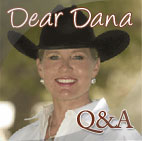California’s gold
Strong Zone 10 Young Rider team in show jumping win in Lexington
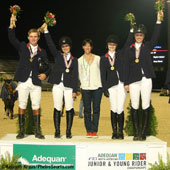
Zone 10 teammates (from left) Richard Neal, Taylor Siebel, Lucy Davis and Saer Coulter take the victory stand along with Chef D’Equipe Mary Manfredi after winning the team competition of the 2010 FEI Adequan American Young Rider Show Jumping competition July 30 at Kentucky Horse Park.
In addition to the California’s Young Riders team title, the Junior Rider team award went to the Alberta, Canada, squad.
A thread between the respective Young Rider and Junior Rider teams is trainer Dick Carvin of Meadow Grove Farm in Lake View Terrace where he trains two of the Young Riders, Lucy Davis and Richard Neal. He also travels to Calgary, Alberta, to train Bretton Chad, a member of the gold medal-winning Canadian Junior Riders.
“I had Ricky and Lucy on the Young Rider Team and Bretton on the Junior team — it was an exciting week,” said Carvin.
Olaf Peterson, Jr. designed a demanding test at Kentucky Horse Park for each group of riders that included a double combination, a triple combination and a tricky open water obstacle. Each rider completed a first round course and the rider with the greatest number of faults had their score dropped before having all faults added together. The six teams with the lowest fault count after the first round returned to tackle the course for a second time in the same format.
Frank ‘Scoop’ Vessels killed in plane crash
Vessels, 58, of Bonsall, was flying his light plane when it crashed at 8:55 a.m. about 80 miles south of Burns, a Harney County Sheriff’s official said. Vessels’s passenger and his friend, Sam Bartley Cannell, 73, of Anderson, also was killed. The two were on their way to Montana from Redding for an annual fishing trip with friends when the 1962 Aero Commander 500-B broke apart and fell from the sky, Sheriff David R. Glerup said. The two men were killed on impact and the aircraft was completely destroyed, Glerup said.
San Diego Co. equestrians set for zoning workshops
Equestrians pursuing working relationships with San Diego County land use staff have scheduled meetings that are open for public participation.
On Aug. 23, the new San Diego County Equestrian Foundation will meet 6:30 to 8:30 p.m. at the Town and Country Resort and Hotel in San Diego. Chandra Waller, general manager of Land Use and Environment, will be on hand along with consulant Jim Whalen of J.Whalen and Associates. For more information, contact Terri Cagle at (760) 720-5088 or visit www.sdcef.org.
Fappani’s Derby reign continues at 2010 Reining by the Bay
 WOODSIDE – Andrea Fappani kept his stronghold on the Reining By The Bay Open Derby last month, taking Custom Smart Olena to a 230.5 that scraped past a pair of 230s in reserve to win the $30,000-added Derby Open. The victory was worth $8,635 for Custom Smart Olena (Custom Crome x A Darn Smart Chic x Smart Chic Olena), owned by Steve Simon of Marietta, Okla.
WOODSIDE – Andrea Fappani kept his stronghold on the Reining By The Bay Open Derby last month, taking Custom Smart Olena to a 230.5 that scraped past a pair of 230s in reserve to win the $30,000-added Derby Open. The victory was worth $8,635 for Custom Smart Olena (Custom Crome x A Darn Smart Chic x Smart Chic Olena), owned by Steve Simon of Marietta, Okla.
Last year at Woodside, Fappani pulled a hat trick I the Derby Open, winning first, second and third places – the championship coming on board Shiner Olena.
The battle for the Derby Open reserve crown featured Wimpys Little Buddy (Wimpys Little Step x All That’s Dun x Hollywood Dun It) ridden by Martin Muehlstatter for Kim Dooley of Scottsdale, Ariz., and Star For The Chicks (Smart Starbuck x Dun It By Chick x Hollywood Dun It), ridden by Randy Paul for Rancho Oso Rio, also of Scottsdale. The matching 230s earned each of them $5,444.
Tieing Around: Lesson learned: Response from pressure
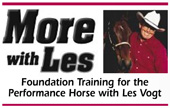 Next in a series
Next in a series
Last issue, we learned how rein position can make a difference. Now we’ll look at tieing around to let him figure out what works best in response to pressure from the bit.
The goal of tieing a horse around is to get him used to giving his neck and to teach him that resistance against the bit is not going to accomplish much for him. It’s a good way to let him figure out the best response to pressure from the bit without him being able to blame you for his discomfort. If the horse is particularly stiff to one direction, there’s nothing wrong with tieing him off to that side every day until he loosens up.
Mexico’s Azcarrago and Selcius up to Blenheim challenge
The Scott Starnes-designed course had several twisty turns and combinations — a total of 16 efforts were included in a tight time allowed of 83 seconds.
“Having not seen a lot of the [Mexican] horses jump, my objective was to get most around but challenge them,” Starnes said. “There was a nice mixture between local and Mexican talent. Azcarraga is a master and he rode really well.”
Nick Haness, Gelato win $10,000 USHJA Derby
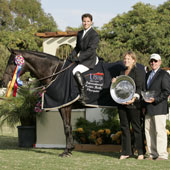
Nick Haness and Gelato with Blenheim EquiSports Marketing Director Melissa Braunstein and Bobby Drennan
Given the 2010/2011 qualifying season’s new scoring, each of the 4’ options jumped was automatically awarded one point, so up to four points were added to both set of judges’ scores.
Sitting third after the first round, Haness and Gelato managed the trot fence, snake jumps and hand gallop with ease, earning the highest handy total of 202. Going in last, Geller can certainly be proud of her first round performance aboard Fabricio; however, an unfortunate rail on the handy course bumped her to seventh position with a score of 239 overall. It was Gelato’s impressive trip that brought their total to 378 overall, four points above Forbes for the win.
Horsetown USA invites everyone to its 2010 ‘Norco Fair’
The Norco Fair 2010 is just around the corner – Sept. 2-6 in Horsetown USA! Hosted by the Norco Fair Committee and held at the George Ingalls Equestrian Event Center, this year’s theme is “Old Town Country Fair.” With more vendors, more rides and more fun, this year’s fair is going to be great! Come celebrate the Labor Day weekend with bull-riding, lawn mower races, ranch rodeo, mutton busting, extreme cowboy games, Miss Horsetown USA pageant, family fun day, magicians — and so much more! Visit www.norcofair.org for ticket info and schedule and see the ad on page 89.
How give-and-take end grab-and-pull
HEY RAY: When I try to flex my horse and he gives to the rein, the minute I give release he grabs and pulls. Do you have any suggestions?
–Francessa Loftis, Placerville, Ca.
HEY FRANCESSA: The good news is that he already gives to the rein, so we might not have to start from the very beginning. For folks who may have a horse that pulls on the rein but doesn’t flex well, they might want to try this:
I’ve talked in the past about patting the horse’s head and or neck until they flex without moving their feet. You can simply use your hand or any extension of your hand that you may see fit to teach them this. It’s important that when the horse is flexing away from you, he makes contact with his belly as if he is going for a target. There are a few reasons why this exercise is valuable.
1. It becomes a clear destination for the horse’s nose.
2. The horse will learn not to overreact to a stimulus that may be unsettling to him. (“desensitization”)
3. This is an opportunity to put meaning to sensation while having the horse trust your hand.
4. It introduces the notion of setting his head in a specific spot, continuously.
These experiences will carry over nicely when you go back to asking for the flexion with the bridle.
While on the ground, work with your horse in a halter. Try not to influence the flexion with the rope — pull until he flexes easily and calmly with the patting. Later, you can transition this into the bridle. When the horse touches his side, rub his nose or the side of his face, but immediately pat again if his nose stops touching his belly. The horse needs to feel that the hand not only initiates the flexion but also finishes the exercise as soon as he gives to it, followed by praise. The horse needs a hand to give to in order to reward himself. The hand teaches the horse the concept of a self-rewarding system that carries over into situations that do not include the hand (i.e. being tied, the constraint of a side rein, or the accidental stepping on his own rein when ground tied. We, as humans, need the hand to influence, but the horse needs our hand to know when he has gotten it right.
Remember that the horse should continue to touch his belly with his nose while you’re rubbing. If he takes his nose off, then go back to the patting until he learns the lesson. Now it’s time to ask for flexion by pulling on the lead rope to a specific spot on his side. While anchoring it, wait for the horse to give. If he does give, release immediately at first, but prolong the release as he gets better. This will teach him the patience that he will need, so that he will stop snatching the rein from you as before. The benefit of patting on the opposite side of the horses face (as opposed to jerking the face back to you with the bit and rein) is that he will learn the lesson without being resentful of your hand, rein and bit. In essence, what you are doing is taking the opportunity away from your horse to pull on you. He cannot pull on a rein that is not there. The new rein aid will simply suggest, not reinforce. The reinforcement will be the job of the patting.
When the horse has no issue maintaining the flexion — for however long you want by this approach — the next step will be to bridle your horse. Ask for the flexion with the rein to a specific spot on the belly of your horse. Francessa, since flexion is not an issue with your horse, this step should go easy. The key here is to remember that as soon as your horse makes the attempt to grab and pull, you should restrain yourself from snatching the rein and pulling back yourself, because he will be expecting that. Instead, proceed with patting as you have been practicing before. Continue this until you have clearly broken the pattern in his mind of pulling and grabbing the rein. Then, and only then, should you attempt to ask for the flexion more assertively with the rein. Initially, the sudden increased pressure may cause your horse to react by resisting or throwing his head. It won’t be long before he will recognize that you are asking him to target that spot on his belly by trying to beat you to the pull. The exercise of patting has prepared him for this step. As he gets better, you will find that he will flex sooner and sooner with less and less resistance. The moment you flex and anchor the rein, your horse should do two things:
1. He should give to the rein and keep his head there without pulling.
2. When he tries to check if it’s okay to straighten himself out (by feeling the hold of the rein against your hand), he should bounce off of it towards his belly.
At that precise moment, give him his head and throw a party. You have both just graduated to another level. You can now move the lesson under saddle.
Francessa, you have given your horse a whole new meaning to the term give and take. This lesson will carry over nicely into many challenges that will include your hand. Have fun with it!
As always, trust your instincts and think safe,
RAY
Horsetrader columnist Ray Ariss, husband to Pippa Ariss and father of six, shares his insight into the relationship of horseand human twice each month, in print and on www.horsetrader.com. He lives and trains in “Horsetown USA”, Norco, Calif., at his bustling Starbrite Riding Academy, where he currently has 50 horses in various stages of training, including Andalusians, Friesians, Quarter Horses, Paints, Thoroughbreds, Arabs, Mustangs and more. Ray attributes his training success to the support of his wife and partner, Pippa, and a system he calls S.W.A.P., to which he credits his multiple championships in several disciplines. His passionate understanding of the “human-horse” relationship was evident when he took on the challenge of training a wild Mustang and — in just 100 days — produced the highest-priced adopted Mustang ever — $50,000. Does your “horse-human relationship” leave you with a question for Ray? Click here to submit one!
Dear Dana:
What is the difference between “feel” and “timing”?
Well, although they are two different things, “feel” and “timing” go hand-in-hand. Timing is knowing when to pick up on your horse, and feel is knowing if your horse “gives” or not — and when to release. You communicate with your horse using your hands, seat and legs, and you develop good communication with feel and timing. An age-old theory says that you either have feel and timing or you don’t, and that neither can be taught. People believed that feel is some elusive, mysterious ability that some great horsemen naturally possess. That is just not true. While there is no doubt that some highly talented people have loads of natural ability in this area, anyone who puts their mind to it can greatly improve. With time, patience and discipline you to can develop feel and improve your timing.
There are five principles to help you accomplish this:
1. Raise Your Level of Awareness
The first and most important principal to remember is to “pay attention”. Pay attention to what your horse is doing underneath you. Learn to read your horse, to diagnose what he’s doing and what you are doing while you are riding him. To start improving your feel and timing, pay attention while riding. You can only fix something if you become aware that there is a problem, so raise your level of awareness.
2. Follow Through
The next important principal is to “follow through”. To follow through means to stay in or bump with your hands or legs until you get the desired response which is a “yes” to your cue! So pay attention because your horse learns by the release. If you bump or take hold of your horse and he pulls down or away from you and you release at the wrong time you just taught him something, maybe the wrong thing, with your release. If you are careful to release each time after you get your desired response he will become lighter and lighter to your cue. So don’t release until you feel him get light and soft in your hands and feel a definite “yes”.
3. Push Through Resistance
When you raise your level of awareness and demand the desired response you may encounter resistance. I encourage you to stay with it until you get your desired response. If he becomes extremely resistant or dangerous, stop what you are doing and seek the help of a professional. I must say that sometimes a horse argues with me right before a big breakthrough. Once I feel him give, I drop right away to teach him that that was what I wanted. Remember a horse learns by the reward.
4. Use a Fair Approach with Your Hands and Legs
The next principal is to pick up fairly. To pick up fairly means do not snatch your horse out of mid-air. If you need to bump or correct your horse sharply you can do so but first approach your horse fairly. That means draw up on the slack in your horse’s reins slowly until you feel his mouth and he knows you are there, and then you can bump or correct or lightly jerk. A horse can take correction if it is given to him fairly with a warning that you are there at the end of the bridle reins. It is unfair to hit the bridle reins with no warning. He needs to feel you coming and good feel means your approach is slow. I tell my riders to draw up on the reins until they feel the horse’s mouth. Teach your horse to trust your hands and take your correction. He will get softer and lighter than ever in your hands. The same applies to your legs or your spur. If you give your leg slowly and then give your cue, he will be more likely respond willingly. If you learn to ask or speak softly through your hands and legs you will develop a willing partner. Of course there are times you need to get tougher to get your point across, but make that the exception — not the rule.
5. Learn to tell the difference between a refusal and an “I don’t understand”
Be open to the fact that you may not be giving a clear cue, or that your horse just doesn’t “get it.” Make your cues extremely clear and easy to understand.
I hope that helps. Once you’ve pushed to this new level and you know what it feels like, don’t settle for less than that! Refine your feel in your hands and legs and rise up to a relationship with your horse that leads to better performance. It is truly awesome when your feel becomes so good that you can feel your horse trying under you and you and your horse become a team!
To read more from Dana on “Feel” and “Timing”, click here.


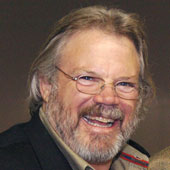
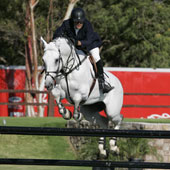
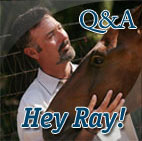
 Read Columns
Read Columns
